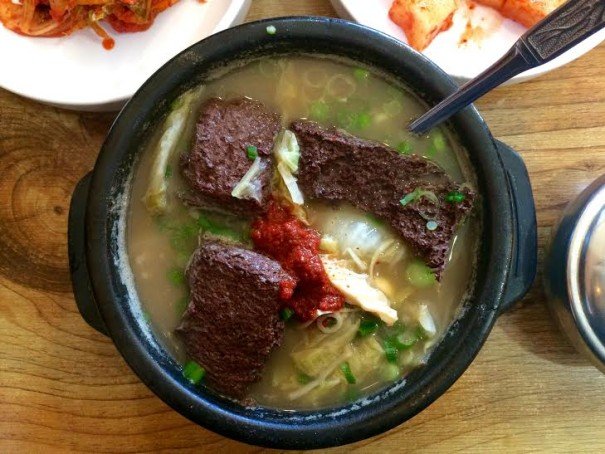
Haejanggook Soup

Haejanggook Soup
Haejanggook in Virginia
Soup in Korea was never meant to be a luxury. It was never supposed to mean anything. There were two reasons for soup: you were poor and you were cold. You were poor so you needed quantity, and you were cold so you wanted something hot. Haejanggook—a popular Korean hangover cure—was incarnated as a way to soothe ailing stomachs and damaged livers, in the cheapest and most efficient ways. Before a long day’s work in the fields, after a long night shift hauling bricks, soup for breakfast was the cure-all. It was never supposed to mean anything. But it means everything.
In a cooking competition show called The Taste, contestants have to prove themselves with one spoonful—one spoon, one bite, one story. Many bites remind you of a dish, but soup embodies a sense of place. A spoonful of haejanggook in the early morning hours not only soothes my innards, it takes me to the foothills of the Sorak mountains of Korea, a bustling pre-dawn fish market, or my grandma’s kitchen. While devised and celebrated as a means to an end, it is so much more now—you are transported, relocated. Transformed.
There was a place, just outside my grandparents’ two-bedroom mountain home, run by an eighty-something-year-old lady and her son. Three, maybe four tables total, and a good hour or two from Seoul—but it served the best haejanggook in the cosmos. Whenever and wherever I eat the dish, I see the creaking sliding door, smell the wood burning through the crisp morning air, and hear the old lady’s clanking in the barely-navigable kitchen. No other Korean restaurant has matched that experience; the taste was never there. But the place was never absent.
This morning is no different. The restaurant I walk into in Centreville, VA, is mostly empty. Four older gents are huddled around a simmering pot of kimchi jjigae a few tables down, pouring each other shots of morning soju. Cheers, they say, and I acknowledge them with a nod. I order my usual, with extra blood cubes.
I look down at the boiling contents of the amber earthenware pot. Silk-soft Napa cabbage resting in a golden hue of dwenjang and ox bone-based broth, immersed in a sea of chopped scallions. Plump cubes of coagulated ox blood protrude from within, like grand peaks of some mountain range at sundown. Red velvet is a word I associate not with fluffy cupcakes, but with blood.
I take a spoonful of the red chili paste and swirl it around in the soup. I watch the soup go from cloudy brown to sunset red. I take a spoonful of the velvet soup, and I’m home. The soup trickles down my throat, illuminating my innards like a campfire. The iron from the blood dances in my mouth alongside a symphony of salty and spicy. This is no umami. This is home.